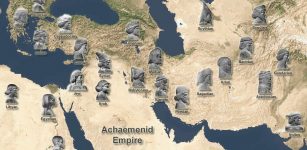Magnificent Pre-Dynastic City Of Sais And Its Lost Neglected Ruins
A. Sutherland - AncientPages.com - The history of Sais goes back to Egypt's pre-dynastic times (before 3100 BC). It was once a beautiful Egyptian city located in the western Egyptian delta along the right bank of the Rosetta Branch of the Nile River.
Left: Goddess Neith. Image credit: Osama Shukir Muhammed Amin FRCP(Glasg) - CC BY-SA 4.0; Right: Goddess Neith. Image credit: Right: Aegis of Neith, Twenty-sixth dynasty of Egypt - Museum of Fine Arts of Lyon. Rama - CC BY-SA 2.0 fr
Today, the only visible ruins of the city near the village of Sa al-Hadjar are dated to the Late New Kingdom (c.1100 BC).
There are no surviving traces of this town prior to this period of time, but it is scientifically attested that the history of Sais goes back to pre-dynastic times. From the 3rd millennium BC, Sais was a famous economic, political, and religious center of the goddess of war and hunting, Neith, whose temple was to be erected by the founder of the first Dynasty.
Known as a center for science and the arts, the city was first mentioned in inscriptions of the archaic period. However, it played an important role in all historical periods and was most important in the late ages. It was then the state capital during the reign of the XXIV and XXVI dynasties.

Herodotus and some other ancient sources confirm that Sais was a prestigious city of northern Egypt about 3100 BC, full of magnificent buildings and royal crypts, and the wives of the rulers of the first Dynasty (Merneit, Meritneit) had come from Sais.
Amasis, who ruled for 44 years and made many contributions to the country, was probably the 5th ruler of Egypt during the 26th Dynasty and has been called the last great Egyptian Pharaoh.
He established himself at Sais in Northern Egypt, and there – like in many other places in Egypt – he ordered the building of monumental buildings, including his tomb at Sais, which was unfortunately never discovered. Still, according to Herodotus' description, the tomb was beautiful:
'It is a great cloistered building of stone, decorated with pillars carved in the imitation of palm-trees, and other costly ornaments. Within the cloister is a chamber with double doors, and behind the doors stands the sepulchre…"
In the age of the Ptolemies (323 to 30 BC), Sais was an important center.
Ancient Sais was the center of the cult of the goddess of war and hunting, Neith, the patron goddess of Sais, a great protector of the people of the land, and the most accomplished mediator between humanity and the gods. From the Late Period (1000 BC onwards), the Neith temple was a center of pilgrimage.
 Head of Amasis II. Saite period, 26th Dynasty, c. 550 BCE. From Egypt. Neues Museum, Berlin, Germany. Greywacke, ÄM 11864. source
Head of Amasis II. Saite period, 26th Dynasty, c. 550 BCE. From Egypt. Neues Museum, Berlin, Germany. Greywacke, ÄM 11864. source
However, Sais had several other temples dedicated to the creator god Atum and one dedicated to the Egyptian Lord of the Underworld and Judge of the Dead, Osiris.
According to Herodotus, the grave of Osiris was located at Sais. The Temple of Sais had a medical school associated with it. The medical school at Sais had many female students and apparently women faculty, mainly in gynecology and obstetrics.
An inscription from the period survives at Sais and reads:
"I have come from the school of medicine at Heliopolis and have studied at the women's school at Sais, where the divine mothers have taught me how to cure diseases…".
Many kings of Sais were clever men; among them was King Nekau of the Twenty-sixth Dynasty, who ruled for 15 years and sent an expedition that circumnavigated Africa. King Nekau was the ruler who started the construction of a canal from the Nile to the Red Sea, later completed by the Achaemenid king Darius I.
 Relief of Psamtik I making an offering to Ra-Horakhty (Tomb of Pabasa). source
Relief of Psamtik I making an offering to Ra-Horakhty (Tomb of Pabasa). source
Necho I, appointed by the Assyrian king Esarhaddon, extended his jurisdiction over the Delta and Memphis after his conquest of Egypt in 671 BC. His son Psamtik I successfully reunited the whole of Egypt and founded the twenty-sixth Dynasty. Later, the successive kings of this Dynasty enlarged and embellished Sais.
The Persians invaded Egypt in 525 BC, just after Psamtek III became king. The fate of the city of Sais is not precisely known, but it is known that after ascending the throne, the Persian king Cambyses marched against Egypt, where he ruined the tomb of Amasis (also known as Ahmose II, which means "The Moon is Born, Son of Neith"). Moreover, he also thoroughly destroyed the city, including several temples.
The city was never subject to systematic archaeological research, and in ancient times, it was better known from historical sources of Herodotus and Strabo and descriptions of travelers.
Written by – A. Sutherland - AncientPages.com Senior Staff Writer
Updated on January 27, 2024
Copyright © AncientPages.com All rights reserved. This material may not be published, broadcast, rewritten or redistributed in whole or part without the express written permission of AncientPages.com
Expand for referencesMore From Ancient Pages
-
 Camas Plant Stewardship In The Pacific Northwest Dates Back More Than 3,500 Years
Archaeology | May 23, 2024
Camas Plant Stewardship In The Pacific Northwest Dates Back More Than 3,500 Years
Archaeology | May 23, 2024 -
 Modern Humans Traveled Across The Eurasian Steppe 45,000 Years Ago
Archaeology | Aug 20, 2019
Modern Humans Traveled Across The Eurasian Steppe 45,000 Years Ago
Archaeology | Aug 20, 2019 -
 Never-Before-Seen 16 Meters Long Ancient Egyptian Papyrus Unveiled To The Public
Artifacts | Feb 21, 2023
Never-Before-Seen 16 Meters Long Ancient Egyptian Papyrus Unveiled To The Public
Artifacts | Feb 21, 2023 -
 Mystery Of The 1,700-Year-Old ‘Salt’ Mummy With Long White Hair
Featured Stories | Sep 14, 2016
Mystery Of The 1,700-Year-Old ‘Salt’ Mummy With Long White Hair
Featured Stories | Sep 14, 2016 -
 Moses’ Secret Knowledge Of Superior And Forbidden Technology – Alien Intervention And Events Erased From Historical Records – Part 2
Biblical Mysteries | Sep 24, 2020
Moses’ Secret Knowledge Of Superior And Forbidden Technology – Alien Intervention And Events Erased From Historical Records – Part 2
Biblical Mysteries | Sep 24, 2020 -
 Shinobi No Mono: The Shadow Warriors And Hattori ‘The Demon’ Hanzo Of Ancient Japan
Featured Stories | Apr 8, 2016
Shinobi No Mono: The Shadow Warriors And Hattori ‘The Demon’ Hanzo Of Ancient Japan
Featured Stories | Apr 8, 2016 -
 Mysterious Moon-Eyed People – Ancient Subterranean Race In Conflict With The Cherokee
Featured Stories | Dec 28, 2017
Mysterious Moon-Eyed People – Ancient Subterranean Race In Conflict With The Cherokee
Featured Stories | Dec 28, 2017 -
 5,000-Year-Old Black Death Victim Challenges Theories Of Development Of Human Civilization
Archaeology | Jul 1, 2021
5,000-Year-Old Black Death Victim Challenges Theories Of Development Of Human Civilization
Archaeology | Jul 1, 2021 -
 On This Day In History: William Of Ockham Secretly Leaves Avignon, Fearing A Death Sentence From Pope – On May 26, 1328
News | May 26, 2016
On This Day In History: William Of Ockham Secretly Leaves Avignon, Fearing A Death Sentence From Pope – On May 26, 1328
News | May 26, 2016 -
 Earliest Fascinating Concepts Of Artificial Intelligence And Robots In Ancient Myths – Examined
Archaeology | Mar 6, 2019
Earliest Fascinating Concepts Of Artificial Intelligence And Robots In Ancient Myths – Examined
Archaeology | Mar 6, 2019 -
 Puzzling Runic Inscription Dated To 1050-1500 AD Unearthed In Oslo, Norway
Archaeology | Dec 13, 2017
Puzzling Runic Inscription Dated To 1050-1500 AD Unearthed In Oslo, Norway
Archaeology | Dec 13, 2017 -
 Rare Byzantine Gold Coin Discovered In Norway – Was It Brought By Harald Hardrada From Constantinople
Archaeology | Dec 12, 2023
Rare Byzantine Gold Coin Discovered In Norway – Was It Brought By Harald Hardrada From Constantinople
Archaeology | Dec 12, 2023 -
 Achaemenid Empire Was The World’s Largest Ancient Empire
Ancient History Facts | Mar 26, 2016
Achaemenid Empire Was The World’s Largest Ancient Empire
Ancient History Facts | Mar 26, 2016 -
 Tribe Recalls Ancient Contact With An Extraterrestrial In The Amazon Jungle And A Strange Beam Of Light
Featured Stories | Jun 25, 2020
Tribe Recalls Ancient Contact With An Extraterrestrial In The Amazon Jungle And A Strange Beam Of Light
Featured Stories | Jun 25, 2020 -
 2,000-Year-Old Stringed Instrument Found In Vietnam
Archaeology | Feb 22, 2023
2,000-Year-Old Stringed Instrument Found In Vietnam
Archaeology | Feb 22, 2023 -
 Why Were These People Buried In A Remote, Unmarked Grave In New Hampshire In The Mid-1800s?
Archaeology | Nov 4, 2024
Why Were These People Buried In A Remote, Unmarked Grave In New Hampshire In The Mid-1800s?
Archaeology | Nov 4, 2024 -
 Humans Survived A Covid-19-Like Pandemic 25,000 Years Ago
Human Beginnings | Nov 23, 2020
Humans Survived A Covid-19-Like Pandemic 25,000 Years Ago
Human Beginnings | Nov 23, 2020 -
 Did The Babylonian Fish-God Oannes Visit Tiahuanacu?
Featured Stories | May 12, 2014
Did The Babylonian Fish-God Oannes Visit Tiahuanacu?
Featured Stories | May 12, 2014 -
 Ancient Secrets Of Karelia: Mysterious Vottovaara Mountain Was Sacred To The Sami People
Featured Stories | Apr 5, 2017
Ancient Secrets Of Karelia: Mysterious Vottovaara Mountain Was Sacred To The Sami People
Featured Stories | Apr 5, 2017 -
 First People To Enter The Americas Brought Their Dogs With Them
Archaeology | Jan 29, 2021
First People To Enter The Americas Brought Their Dogs With Them
Archaeology | Jan 29, 2021

